
Solar eclipse of June 8, 1937
| Solar eclipse of June 8, 1937 | |
|---|---|
 The solar eclipse as viewed from Kanton Island. | |
| Type of eclipse | |
| Nature | Total |
| Gamma | −0.2253 |
| Magnitude | 1.0751 |
| Maximum eclipse | |
| Duration | 424 s (7 min 4 s) |
| Coordinates | 9°54′N 130°30′W / 9.9°N 130.5°W |
| Max. width of band | 250 km (160 mi) |
| Times (UTC) | |
| Greatest eclipse | 20:41:02 |
| References | |
| Saros | 136 (33 of 71) |
| Catalog # (SE5000) | 9369 |
A total solar eclipse occurred at the Moon's descending node of orbit between Tuesday, June 8 and Wednesday, June 9, 1937,[1] with a magnitude of 1.0751. A solar eclipse occurs when the Moon passes between Earth and the Sun, thereby totally or partly obscuring the image of the Sun for a viewer on Earth. A total solar eclipse occurs when the Moon's apparent diameter is larger than the Sun's, blocking all direct sunlight, turning day into darkness. Totality occurs in a narrow path across Earth's surface, with the partial solar eclipse visible over a surrounding region thousands of kilometres wide. Occurring about 16 hours after perigee (on June 8, 1937, at 4:30 UTC), the Moon's apparent diameter was larger.[2]

With a maximum eclipse of 7 minutes and 4.06 seconds, this was the longest total solar eclipse since July 1, 1098, which lasted 7 minutes and 5.34 seconds. A longer total solar eclipse occurred on June 20, 1955.[3][4][5][6][7]

The path of totality crossed the Pacific Ocean starting in Gilbert and Ellice Islands (now belonging to Tuvalu and Kiribati) on June 9 (Wednesday), and ending at sunset in Peru on June 8 (Tuesday). At sunrise totality lasted 3 minutes, 6.8 seconds and at sunset totality lasted 3 minutes, 5.1 seconds. A partial eclipse was visible for parts of Oceania, Hawaii, southern North America, Central America, the Caribbean, and western South America. American astronomy professor Ethelwynn Rice Beckwith traveled to Peru to see this eclipse, and described the event in detail for the Oberlin Alumnae Magazine in 1937, in an article titled "Three Minutes in Peru."[8]

Observations
Scientists from the United States, United Kingdom and New Zealand observed the total eclipse in Canton Island, Phoenix Islands. The American expedition was organized by the National Geographic Society and assisted by the United States Navy. This total solar eclipse was memorable for three reasons: first, the duration of totality was particularly long with the longest point in eastern Pacific exceeding 7 minutes; second, despite being in the tropics, weather was good for all observation sites; third, broadcasts were made through radio before, during and after the eclipse through long distances so people could hear the details.[9][10]

Eclipse details
Shown below are two tables displaying details about this particular solar eclipse. The first table outlines times at which the moon's penumbra or umbra attains the specific parameter, and the second table describes various other parameters pertaining to this eclipse.[11]

| Event | Time (UTC) |
|---|---|
| First Penumbral External Contact | 1937 June 08 at 18:04:51.1 UTC |
| First Umbral External Contact | 1937 June 08 at 18:59:01.4 UTC |
| First Central Line | 1937 June 08 at 19:00:34.9 UTC |
| First Umbral Internal Contact | 1937 June 08 at 19:02:08.4 UTC |
| First Penumbral Internal Contact | 1937 June 08 at 19:58:44.5 UTC |
| Greatest Duration | 1937 June 08 at 20:40:34.6 UTC |
| Greatest Eclipse | 1937 June 08 at 20:41:01.5 UTC |
| Equatorial Conjunction | 1937 June 08 at 20:41:09.6 UTC |
| Ecliptic Conjunction | 1937 June 08 at 20:43:19.5 UTC |
| Last Penumbral Internal Contact | 1937 June 08 at 21:23:18.0 UTC |
| Last Umbral Internal Contact | 1937 June 08 at 22:19:55.6 UTC |
| Last Central Line | 1937 June 08 at 22:21:28.3 UTC |
| Last Umbral External Contact | 1937 June 08 at 22:23:00.9 UTC |
| Last Penumbral External Contact | 1937 June 08 at 23:17:13.7 UTC |
| Parameter | Value |
|---|---|
| Eclipse Magnitude | 1.07513 |
| Eclipse Obscuration | 1.15590 |
| Gamma | −0.22532 |
| Sun Right Ascension | 05h06m06.4s |
| Sun Declination | +22°52'06.5" |
| Sun Semi-Diameter | 15'45.2" |
| Sun Equatorial Horizontal Parallax | 08.7" |
| Moon Right Ascension | 05h06m06.1s |
| Moon Declination | +22°38'22.0" |
| Moon Semi-Diameter | 16'39.4" |
| Moon Equatorial Horizontal Parallax | 1°01'08.0" |
| ΔT | 23.9 s |
Eclipse season
This eclipse is part of an eclipse season, a period, roughly every six months, when eclipses occur. Only two (or occasionally three) eclipse seasons occur each year, and each season lasts about 35 days and repeats just short of six months (173 days) later; thus two full eclipse seasons always occur each year. Either two or three eclipses happen each eclipse season. In the sequence below, each eclipse is separated by a fortnight.

| May 25 Ascending node (full moon) |
June 8 Descending node (new moon) |
|---|---|
 |

|
| Penumbral lunar eclipse Lunar Saros 110 |
Total solar eclipse Solar Saros 136 |
Related eclipses
Eclipses in 1937
- A penumbral lunar eclipse on May 25.
- A total solar eclipse on June 8.
- A partial lunar eclipse on November 18.
- An annular solar eclipse on December 2.
Metonic
- Preceded by: Solar eclipse of August 21, 1933
- Followed by: Solar eclipse of March 27, 1941
Tzolkinex
- Preceded by: Solar eclipse of April 28, 1930
- Followed by: Solar eclipse of July 20, 1944
Half-Saros
- Preceded by: Lunar eclipse of June 3, 1928
- Followed by: Lunar eclipse of June 14, 1946
Tritos
- Preceded by: Solar eclipse of July 9, 1926
- Followed by: Solar eclipse of May 9, 1948
Solar Saros 136
- Preceded by: Solar eclipse of May 29, 1919
- Followed by: Solar eclipse of June 20, 1955
Inex
- Preceded by: Solar eclipse of June 28, 1908
- Followed by: Solar eclipse of May 20, 1966
Triad
- Preceded by: Solar eclipse of August 7, 1850
- Followed by: Solar eclipse of April 8, 2024
Solar eclipses of 1935–1938
This eclipse is a member of a semester series. An eclipse in a semester series of solar eclipses repeats approximately every 177 days and 4 hours (a semester) at alternating nodes of the Moon's orbit.[12]

The partial solar eclipses on February 3, 1935 and July 30, 1935 occur in the previous lunar year eclipse set.

| Solar eclipse series sets from 1935 to 1938 | ||||||
|---|---|---|---|---|---|---|
| Ascending node | Descending node | |||||
| Saros | Map | Gamma | Saros | Map | Gamma | |
| 111 | January 5, 1935 Partial |
−1.5381 | 116 | June 30, 1935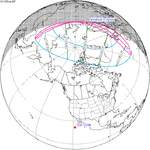 Partial |
1.3623 | |
| 121 | December 25, 1935 Annular |
−0.9228 | 126 | June 19, 1936 Total |
0.5389 | |
| 131 | December 13, 1936 Annular |
−0.2493 | 136 Totality in Kanton Island, Kiribati |
June 8, 1937 Total |
−0.2253 | |
| 141 | December 2, 1937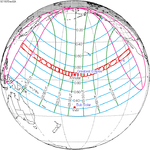 Annular |
0.4389 | 146 | May 29, 1938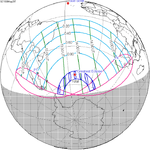 Total |
−0.9607 | |
| 151 | November 21, 1938 Partial |
1.1077 | ||||
Saros 136
This eclipse is a part of Saros series 136, repeating every 18 years, 11 days, and containing 71 events. The series started with a partial solar eclipse on June 14, 1360. It contains annular eclipses from September 8, 1504 through November 12, 1594; hybrid eclipses from November 22, 1612 through January 17, 1703; and total eclipses from January 27, 1721 through May 13, 2496. The series ends at member 71 as a partial eclipse on July 30, 2622. Its eclipses are tabulated in three columns; every third eclipse in the same column is one exeligmos apart, so they all cast shadows over approximately the same parts of the Earth.

The longest duration of annularity was produced by member 9 at 32 seconds on September 8, 1504, and the longest duration of totality was produced by member 34 at 7 minutes, 7.74 seconds on June 20, 1955. All eclipses in this series occur at the Moon’s descending node of orbit.[13]

| Series members 26–47 occur between 1801 and 2200: | ||
|---|---|---|
| 26 | 27 | 28 |
 March 24, 1811 |
 April 3, 1829 |
 April 15, 1847 |
| 29 | 30 | 31 |
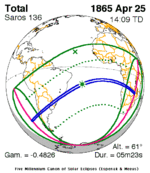 April 25, 1865 |
 May 6, 1883 |
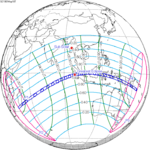 May 18, 1901 |
| 32 | 33 | 34 |
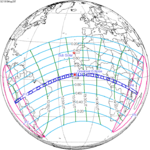 May 29, 1919 |
 June 8, 1937 |
 June 20, 1955 |
| 35 | 36 | 37 |
 June 30, 1973 |
 July 11, 1991 |
 July 22, 2009 |
| 38 | 39 | 40 |
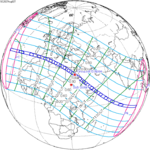 August 2, 2027 |
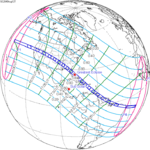 August 12, 2045 |
 August 24, 2063 |
| 41 | 42 | 43 |
 September 3, 2081 |
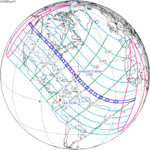 September 14, 2099 |
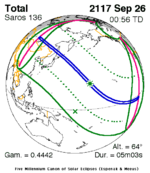 September 26, 2117 |
| 44 | 45 | 46 |
 October 7, 2135 |
 October 17, 2153 |
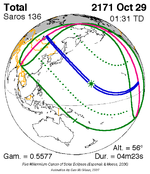 October 29, 2171 |
| 47 | ||
 November 8, 2189 | ||
Metonic series
The metonic series repeats eclipses every 19 years (6939.69 days), lasting about 5 cycles. Eclipses occur in nearly the same calendar date. In addition, the octon subseries repeats 1/5 of that or every 3.8 years (1387.94 days). All eclipses in this table occur at the Moon's descending node.

| 22 eclipse events between March 27, 1884 and August 20, 1971 | ||||
|---|---|---|---|---|
| March 27–29 | January 14 | November 1–2 | August 20–21 | June 8 |
| 108 | 110 | 112 | 114 | 116 |
 March 27, 1884 |
 August 20, 1895 |
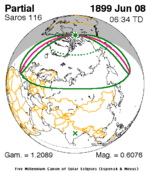 June 8, 1899 | ||
| 118 | 120 | 122 | 124 | 126 |
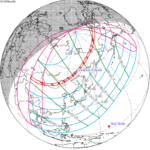 March 29, 1903 |
 January 14, 1907 |
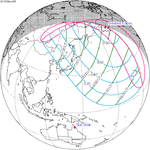 November 2, 1910 |
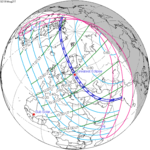 August 21, 1914 |
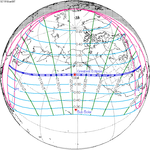 June 8, 1918 |
| 128 | 130 | 132 | 134 | 136 |
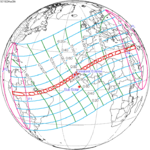 March 28, 1922 |
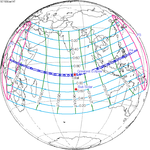 January 14, 1926 |
 November 1, 1929 |
 August 21, 1933 |
 June 8, 1937 |
| 138 | 140 | 142 | 144 | 146 |
 March 27, 1941 |
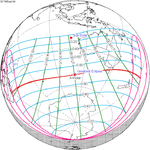 January 14, 1945 |
 November 1, 1948 |
 August 20, 1952 |
 June 8, 1956 |
| 148 | 150 | 152 | 154 | |
 March 27, 1960 |
 January 14, 1964 |
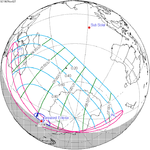 November 2, 1967 |
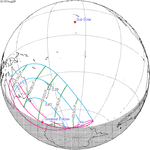 August 20, 1971 | |
Tritos series
This eclipse is a part of a tritos cycle, repeating at alternating nodes every 135 synodic months (≈ 3986.63 days, or 11 years minus 1 month). Their appearance and longitude are irregular due to a lack of synchronization with the anomalistic month (period of perigee), but groupings of 3 tritos cycles (≈ 33 years minus 3 months) come close (≈ 434.044 anomalistic months), so eclipses are similar in these groupings.

| Series members between 1801 and 2200 | ||||
|---|---|---|---|---|
 June 16, 1806 (Saros 124) |
 May 16, 1817 (Saros 125) |
 April 14, 1828 (Saros 126) |
 March 15, 1839 (Saros 127) |
 February 12, 1850 (Saros 128) |
 January 11, 1861 (Saros 129) |
 December 12, 1871 (Saros 130) |
 November 10, 1882 (Saros 131) |
 October 9, 1893 (Saros 132) |
 September 9, 1904 (Saros 133) |
 August 10, 1915 (Saros 134) |
 July 9, 1926 (Saros 135) |
 June 8, 1937 (Saros 136) |
 May 9, 1948 (Saros 137) |
 April 8, 1959 (Saros 138) |
 March 7, 1970 (Saros 139) |
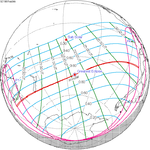 February 4, 1981 (Saros 140) |
 January 4, 1992 (Saros 141) |
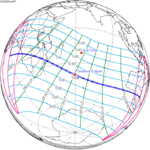 December 4, 2002 (Saros 142) |
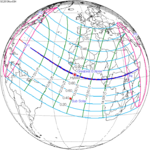 November 3, 2013 (Saros 143) |
 October 2, 2024 (Saros 144) |
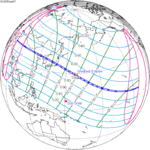 September 2, 2035 (Saros 145) |
 August 2, 2046 (Saros 146) |
 July 1, 2057 (Saros 147) |
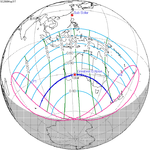 May 31, 2068 (Saros 148) |
 May 1, 2079 (Saros 149) |
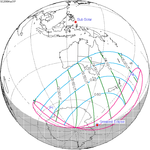 March 31, 2090 (Saros 150) |
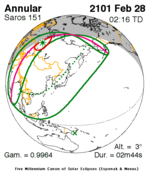 February 28, 2101 (Saros 151) |
 January 29, 2112 (Saros 152) |
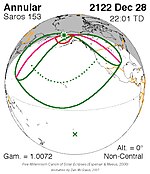 December 28, 2122 (Saros 153) |
 November 26, 2133 (Saros 154) |
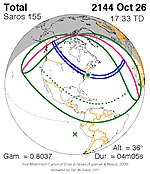 October 26, 2144 (Saros 155) |
 September 26, 2155 (Saros 156) |
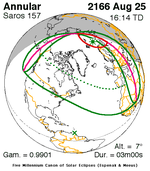 August 25, 2166 (Saros 157) |
 July 25, 2177 (Saros 158) |
 June 24, 2188 (Saros 159) |
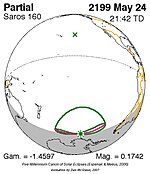 May 24, 2199 (Saros 160) | |||
Inex series
This eclipse is a part of the long period inex cycle, repeating at alternating nodes, every 358 synodic months (≈ 10,571.95 days, or 29 years minus 20 days). Their appearance and longitude are irregular due to a lack of synchronization with the anomalistic month (period of perigee). However, groupings of 3 inex cycles (≈ 87 years minus 2 months) comes close (≈ 1,151.02 anomalistic months), so eclipses are similar in these groupings.

| Series members between 1801 and 2200 | ||
|---|---|---|
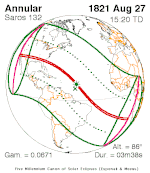 August 27, 1821 (Saros 132) |
 August 7, 1850 (Saros 133) |
 July 19, 1879 (Saros 134) |
 June 28, 1908 (Saros 135) |
 June 8, 1937 (Saros 136) |
 May 20, 1966 (Saros 137) |
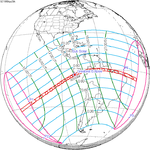 April 29, 1995 (Saros 138) |
 April 8, 2024 (Saros 139) |
 March 20, 2053 (Saros 140) |
 February 27, 2082 (Saros 141) |
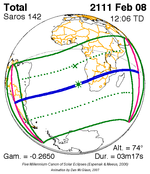 February 8, 2111 (Saros 142) |
 January 20, 2140 (Saros 143) |
 December 29, 2168 (Saros 144) |
 December 9, 2197 (Saros 145) |
|
See also
- Kanton Island § Americans arrive - describing events where a Pacific island disputed between the UK and the US was used to view the eclipse
Notes
- ^ "June 8, 1937 Total Solar Eclipse". timeanddate. Retrieved 3 August 2024.
- ^ "Moon Distances for London, United Kingdom, England". timeanddate. Retrieved 3 August 2024.
- ^ Espenak, Fred. "Total Solar Eclipses with Durations Exceeding 07m 00s: -3999 to 6000". NASA Eclipse Web Site.
- ^ "Isle Eclipse Group Anxious To Return To Mainland". The Honolulu Advertiser. Honolulu, Hawaii. 1937-06-09. p. 2. Retrieved 2023-10-17 – via Newspapers.com.
- ^ "Solar Eclipse: To-day's Phenomenon". The Sydney Morning Herald. Sydney, New South Wales, New South Wales, Australia. 1937-06-09. p. 14. Retrieved 2023-10-17 – via Newspapers.com.
- ^ "Scientists Get Good Pictures Of Eclipse". Arizona Republic. Phoenix, Arizona. 1937-06-09. p. 1. Retrieved 2023-10-17 – via Newspapers.com.
- ^ "Eclipse and Shadow of Moon On Earth Photographed From Plane 5 Miles High, Other Good Shots". St. Louis Post-Dispatch. St. Louis, Missouri. 1937-06-09. p. 19. Retrieved 2023-10-17 – via Newspapers.com.
- ^ Beckwith, Ethelwynn Rice (November 1937). "Three Minutes in Peru". Oberlin Alumnae Magazine: 2–3 – via Internet Archive.
- ^ Mitchell, S. A. (February 1938). "The Total Eclipse Observed on Canton Island". Publications of the Astronomical Society of the Pacific. 50 (293): 23. Bibcode:1938PASP...50...23M. doi:10.1086/124881. ISSN 0004-6280. Archived from the original on 26 February 2022.
- ^ Michie, C. B. (1 December 1938). "Report of the New Zealand Total Solar Eclipse Expedition to Canton Island, 1937 June 8". Monthly Notices of the Royal Astronomical Society. 99 (2): 132–135. doi:10.1093/mnras/99.2.132. ISSN 0035-8711.
- ^ "Total Solar Eclipse of 1937 Jun 08". EclipseWise.com. Retrieved 3 August 2024.
- ^ van Gent, R.H. "Solar- and Lunar-Eclipse Predictions from Antiquity to the Present". A Catalogue of Eclipse Cycles. Utrecht University. Retrieved 6 October 2018.
- ^ "NASA - Catalog of Solar Eclipses of Saros 136". eclipse.gsfc.nasa.gov.
References
See what we do next...
OR
By submitting your email or phone number, you're giving mschf permission to send you email and/or recurring marketing texts. Data rates may apply. Text stop to cancel, help for help.
Success: You're subscribed now !




